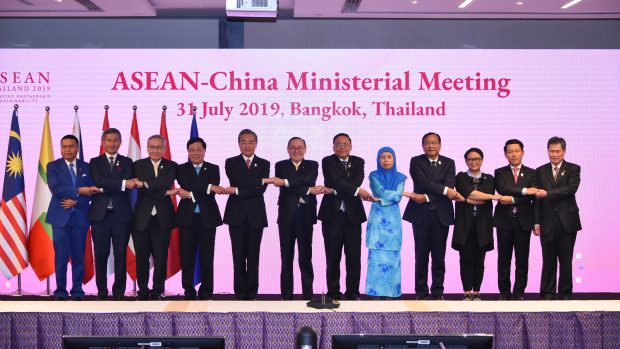
South China Sea Code of Conduct

By Ivan Lim
Contributor to AsiaN
Singapore: The long-awaited South China Sea Code of Conduct for peaceful resolution of disputes will be ready in three years, China and Asean have agreed.
This was the key outcome of the Asean Foreign Ministers meeting with their Chinese counterpart.at their annual gathering in the Thai capital, Bangkok on July 31.
The parties also agreed to speed up the reading of the single draft of the code of conduct negotiating text by this year.
“It is an important step towards the goal of concluding consultations within three years,” said China’s Foreign Minister Wang Yi.
The 2021 timeline for the good neighbour conduct protocol put behind it past naval skirmishes over sovereignty, fishing ground and oil-gas exploration rights in the South China Sea.
The urgency to adopt the Code of Conduct was underlined by recent flare-ups. In June, the collision between a Chinese and Filipino fishing vessel that left 22 Filipino fishermen stranded in the West Philippines Sea sparked protests in Manila. The incident also put pressure on Philippine President Rodrigo Duterte to take a tougher line against Beijing.
In early July, the entry of a Chinese survey vessel into Vietnam Exclusive Economic Zone led Hanoi to call for international efforts to restrain China.
In their dealings with their next-door giant, Asia’s. largest country with its 1.43 billion population, the Asean states certainly recall Napoleon Bonaparte’s warning about the 3,000-year old colossal: China is a sleeping lion. Let her sleep. For when she wakes, she will shake the world.
Indeed, China has churned the waters in the South China Sea by claiming as much as 90 percent of the vital waterways through which $3.4. trillion of the world’s trade flows. The People’s Republic of China validates its maritime claims on the basis of a 1947 map depicting a U-shaped 11-dash line, subsequently trimmed to nine, that encompasses islands, reefs and atolls that the then Nationalist government repossessed from the Japanese at the end of World War Two.
The nine-dash line defines 2000km of maritime territory from the Chinese mainland to within few hundred kilometres of neighbouring Vietnam, Philippines and Malaysia.
Under the 1982 United Nations Law of the Sea. (UNCLOS), states enjoys an exclusive economic zone of 200 nautical miles from their low-water line.
Their intersecting maritime lines have led to disputed claims between China and Vietnam and Philippines. over Spratly Islands, Paracel Islands and Scarborough Shoal. Two other claimant states, Malaysia and Brunei, have not taken up cudgels with China.
In 2012, things came to a head when a Philippines coastguard vessel stopped eight Chinese fishing boats at the Scarborough Shoal in the Spratlys chain. The coastguard crew tried to detain the fishermen for illegal poaching when Chinese maritime ships came on the scene, leading to a face-off. Tensions eased off after the United States stepped in to mediate. But the Chinese took over control of the Scarborough Shoal after the Philippines ships withdrew from the area.
In 2014, a Chinese oil rig entered disputed waters in the Spratlys led to vessel ramming setting off protests by Vietnam. With Asean backing, Hanoi pushed for the establishment of some mechanism for negotiations.
Choosing a legal approach, the Philippines in 2014 unilaterally filed its case with the Permanent Court of Arbitration in the Hague on the basis of UNCLOS.
In 2016, the Court ruled that China’s historic claims over South China Sea was legally incompatible with the UNCLOS.
An increasingly assertive Beijing rejected the ruling. Instead, it proposed bi-lateral negotiations with the claimant-states.
China is keen to keep United States out of the South China Sea maritime spats.
The US have been sending its warships to sail close by disputed islands which China had fortified with airstrips and missile launching facilities, ostensibly to uphold freedom of navigation in the South China Sea but also to challenge Beijing’s rising profile.
Once in place, the China-Asean Code of Conduct will help tamp down the big-power confrontations arising from the South China Sea flashpoints.


